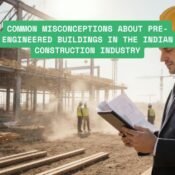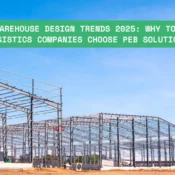
How Pre-Engineered Steel Buildings Enhance Industrial Construction Projects in India
Introduction
In the industrial construction realm, businesses are challenged today more than ever before with meeting deadlines, cost controls, and ensuring structural soundness. Indian construction projects, particularly in the industrial sector, have increasingly turned to the use of pre-engineered steel buildings (PEBs) to address some of these issues.
Picture a manufacturing company whose business owner is trying to keep up with the ever-growing requirements of the production line. Now imagine if a construction company’s expansion is halfway done and traditional construction techniques are causing further delay in the expansion. Every project has its schedule, labor cost, and weather related constraints, which if not handled precisely can jeopardize the entire endeavor. In this scenario, pre-engineered steel buildings not only alleviate the issues but also offer numerous advantages such expeditious construction, cost saving, sustainability, and enduring longevity.
In this blog, we will examine the impact of pre-engineered steel buildings (PEBs) on Indian industrial construction. We will start from the key advantages of PEBs to understanding the material options, design flexibility, and all the factors which are making PEBs a popular preference for industrial projects across the country. So, let us explore the impact of PEB construction and the way they are changing the industrial construction paradigm.
Table of Contents
- Why Pre-Engineered Steel Buildings Are Becoming Popular in Industrial Construction
- Key Advantages of Pre-Engineered Steel Buildings for Industrial Projects
- Flexibility in Materials and Design of Pre-Engineered Buildings (PEBs)
- The Economic and Environmental Benefits of PEB Construction
- The Impact of PEB on Industrial Project Efficiency
- Conclusion
- Frequently Asked Questions
Why Pre-Engineered Steel Buildings Are Becoming Popular in Industrial Construction
All along, conventional techniques used for industrial construction required intricate procedures, consumed plenty of time, and cost a fortune. With the evolving demands of the modern industrial sector, there’s been a strong shift towards adopting innovative and more efficient solutions. Enter pre-engineered steel buildings (PEBs).
Pre-engineered steel buildings are assembled off-site in a factory where parts like beams, columns, and roof systems are manufactured. They are shipped to the construction site where they are assembled. This reduces on-site construction time and improves overall industrial construction efficiency. In India, where rapid urbanization and industrial expansion are in full swing, PEBs are helping businesses overcome the challenges associated with traditional construction methods.
The lightweight nature of PEBs (pre-engineered buildings) does not compromise their strength, which is one of the primary reasons they are favored in industrial construction. This is particularly useful for expansive industrial works like warehouses, factories, and manufacturing plants that need well-designed sturdy buildings at a reasonable price.
Moreover, PEB construction provides superior flexibility in design. Be it a vast open span for the movement of machines or special consideration for the placement of heavy equipment. PEBs are customizable to a wide range of requirements. This versatility sets PEBs apart and makes them well-suited for all types of industrial constructions.

Key Advantages of Pre-Engineered Steel Buildings for Industrial Projects
In the past couple of years, there has been a surge in the number of businesses opting for pre-engineered steel buildings for their industrial construction projects, and for good reason. Some of these advantages are listed below.
- Reduced Construction Time
In the industrial realm, time equates to money. PEBs are manufactured in specially designed factories under controlled conditions, which means all the work that can be done off-site will be done prior to visiting, and only assembly is done on-site. This drastic difference in methods allows for industrial construction projects that utilize PEBs to be completed much quicker. Faster construction means sooner operations, which leads to reduced downtime and increased productivity.
- Cost-Effectiveness
The PEB constriction processes impact expenditures greatly. The prefabrication technique lowers material costs, while speed increases productivity and labor expenses in the construction phase. In addition, PEBs usually require fewer workers to be present on-site, further enhancing savings. The benefits to the steel building’s construction economics are apparent: decreasing capital expenditures, lesser operational setbacks, and perpetual finances.
- Durability and Strength
PEBs are extremely durable. These buildings are crafted from quality steel and can endure harsh weather conditions like strong winds, rains, and even earthquakes. For industrial construction projects in India with fluctuating climates and environmental conditions, pre-engineered steel buildings are exceptionally durable, making them a favorable option.
- Sustainability
As India shifts toward adopting more green building techniques, PEBs would perfectly align with them. Steel is an eco-friendly resource, hence PEB construction poses fewer carbon footprints in contrast to other building materials. Also, PEBs often adopt anticipatory energy systems, which aids in sustainable construction.
Flexibility in Materials and Design of Pre-Engineered Buildings (PEBs)
The materials chosen in Pre-Engineered Steel Buildings (PEBs) greatly influences their adaptability. Steel possesses exceptional strength, and more importantly, it is pliable, providing a variety of design options. The components incorporated into PEBs, from the roof panels to the entire wall systems, can be tailored to any project's specifics.
As noted above, the design flexibility of PEBs represents a fundamental advantage as well. If you require extra-high ceilings, extensive column-free spaces, or dedicated zones for distinct types of equipment, PEBs can be tailored to fulfill the wide-ranging needs of industrial construction. It is common that manufacturing plants need substantial cramped internal space, housing machinery and stockpiles of external goods. PEBs can facilitate these spaces without the use of internal columns or supports, which makes PEBs ideal for such projects.
PEBs may also include other design options such as adding insulation to control temperature, the use of fire retardant materials for safety, and customizable fire resistant finishes for aesthetic purposes. These design qualities greatly improve the adaptability of PEBs to different industrial needs.
The use of PEBs has increased the amount of opportunity available for sustaining economic growth and efficiency, as well as reducing carbon output due to the steel’s recycling benefits. As industrial construction grows throughout India, industries are becoming more concerned about their economic and environmental impact. PEBs offer numerous opportunities to satisfy both needs.

The Economic and Environmental Benefits of PEB Construction
Economic Benefits:
Decreased Construction Completion Time: Faster assembly means avoiding costly delays associated with complex problems.
Lower Costs for Employees: With less on-site fabrication, fewer workers are needed at the site to manage the labor tasks, reducing labor expenditures.
Increased Energy Efficiency: Businesses that operate from these PEBs will incur decreased long-term operational costs since many are designed to be energy efficient.
Environmental Benefits:
Decreased Material Waste: Construction work becomes less wasteful due to precise cutting prefabrication since components are manufactured separately to exact dimensions.
Steels high recyclability renders PEBs eco-friendly, enabling the complete recycling of Steel used to manufacture them.
Lower Carbon Footprint: The excessive use of on-site construction loitering and the on-site work that comes with using PEBs is counterproductive and therefore, PEBs can lower the ascribed carbon footprint of the project.
The Impact of PEB on Industrial Project Efficiency
INDIA’S proclivity towards pre-engineered steel buildings is currently on the rise and for good reason. Prefabricated elements positively influence the design, construction, and operation phases of an industrial project on all levels.
Simplified Construction Procedures: Work that requires considerable manpower, especially during the construction phase, is streamlined. Businesses can concentrate on their core functions instead of handling construction delays and complications due to the prefabricated units.
Customizable Structural Features:
PEBs offer designs that can be customized to fit particular requirements of various industries such as heavy manufacturing, warehousing, and logistics.
Operational Cost Effectiveness:
PEBs are fundamentally offset by the reduction in maintenance costs because PEBs are constructed from strong, long-lasting materials that are designed to be energy-efficient, helping the facility’s operational productivity in the long run.

"At Metal Tree, we believe in shaping the future of industrial construction with innovative and sustainable solutions. Our pre-engineered steel buildings (PEBs) are designed to not only meet the demands of modern industries but also to enhance efficiency, reduce costs, and support long-term growth. With each project, we aim to deliver strength, flexibility, and sustainability, making construction faster, smarter, and more environmentally responsible."

Conclusion
PEBs are certainly changing the face of industrial construction in India for the better. Their foremost benefits include quick construction times, lower costs, flexible design options, and sustainability. Industries will be able to further improve their operations and enhance business by adopting PEB construction, thus spending less while future-proofing their facilities with resilient, flexible, and sustainable structures.
Reach out to Metal Tree, one of the most trusted names in PEB construction in India, and let us help make your industrial project a success. You will not regret investing your time into learning about the revolutionary advantages of pre-engineered steel buildings for your industrial projects.
Frequently Asked Questions
What makes pre-engineered steel buildings so attractive?
In addition to lower project costs, PEBs have faster construction rates, and greater flexibility in design, all while being durable and environmental friendly.
How much time is required to erect a pre-engineered steel structure?
Construction time for PEBs is significantly reduced compared to traditional building methods, often completing in a fraction of the time.
Are pre-engineered steel buildings environmentally friendly?
Yes, PEBs are made of recyclable steel and often feature energy-efficient designs, reducing the environmental impact.
What types of industrial projects benefit from pre-engineered steel buildings?
Manufacturing plants, warehouses, and other industrial facilities can greatly benefit from PEBs due to their customizable designs and strength.
Ready to upgrade?
📞 Contact Metal Tree for custom PEB solutions tailored to your needs!
Follow us on:
2 thoughts on “How Pre-Engineered Steel Buildings Enhance Industrial Construction Projects in India”
Add a Comment Cancel reply
All Categories
Recent Posts
How Much Does a Pre-Engineered Building Cost in India? Ultimate Price Guide
Tags
Call Us at
+91 9311624628





[…] make matters worse, their competitors who opted for the pre-engineered steel construction method completed their projects dramatically faster and cheaper, sometimes up to 40% faster. Fast forward to now, lots of […]
[…] Pre-engineered building projects are fundamentally different from traditional construction. While they offer significant advantages,such as reduced build time, cost control, and scalability,they also require precise coordination, particularly between: […]